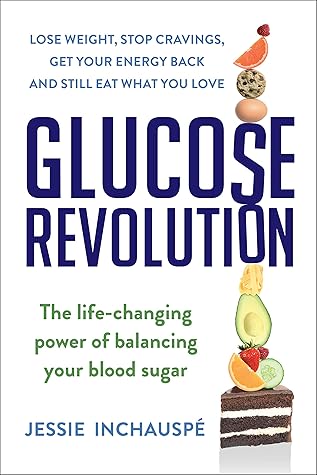More on this book
Community
Kindle Notes & Highlights
Read between
September 22 - September 23, 2025
And it’s linked to glucose, fructose, and insulin.
science is finding that even if our fasting glucose is normal, each additional glucose spike increases our risk of dying of a heart attack.
what’s important is LDL pattern B and inflammation.
If you divide the level of triglycerides (in mg/dL) by HDL level (in mg/dL), you’ll get a ratio that
is surprisingly accurate in predicting LDL size. If the result is smaller than 2, that’s ideal. If the result is above 2, it can be problematic.
prediabetes (fasting glucose levels above 100 mg/dL) to type 2 diabetes (above 126 mg/dL).
most effective way to reverse type 2 diabetes is to flatten our glucose curves.
excess fructose could cause liver disease, just as alcohol does.
glycation makes us age faster and look older.
EAT FOODS IN THE RIGHT ORDER
Two meals consisting of the same foods (and therefore the same nutrients and the same calories) can have vastly different impacts on our body depending on how their components are eaten.
you reduce your overall glucose spike by 73 percent, as well as your insulin spike by 48 percent.
standardized diet for eight weeks
The group who ate their food in the right order saw a significant reduction in their HbA1c level, which means they started reversing their type 2 diabetes.
Any starch or sugar that we eat after fiber will have a reduced effect on our body.
pleasure from eating it but with fewer consequences.
Protein is found in meat, fish, eggs, dairy, nuts, beans, and legumes. Foods that contain protein often contain fat, too, and fat is also found on its own i...
This highlight has been truncated due to consecutive passage length restrictions.
Eating carbs after everything else is the best move.
veggies first, protein and fats second, carbs last—not
We can eat exactly the same thing—but by eating carbs last, we make a big difference in our physical and mental well-being.
Deconstruct a sandwich and eat the bread (starch) last to dampen the glucose spike it creates and get rid of the 3 p.m. sleepiness
eat the veggies and proteins first and the carbs last. Note how you feel after eating compared to how you usually feel after a meal.
Even if there are no veggies on your plate, “deconstructing” your meals and eating carbs last helps your body.
fruit. I categorize fruits in the “sugars” category,
As long as you eat starch and sugars last, even if it’s without stopping, you will flatten your glucose curve.
The most important thing to remember is that it’s best to eat starches and sugars as late in the meal as possible.
Start with the veggies and greens on your plate, then fat and protein, then starches and sugars.
Based on the science, I love any meal that starts with a salad.
Starting with starch is the absolute opposite of what you ought to do.
ADD A GREEN STARTER TO ALL YOUR MEALS
By adding a delicious green starter, we’re bringing fiber back.
The first course of each dinner was always a large salad.
a first course every night of a large salad.
Only 5 percent of Americans meet the recommended daily amount: 25 grams per day.
you get most of your fiber from beans, vegetables, and fruit.
Beans, leafy greens, and veggies are great sources of fiber.
fed participants two types of bread: regular bread and enriched bread with 10 grams of fiber per serving. They found that the additional fiber reduced the glucose spike of the bread by over 35 percent.
Green veggies. These contain mostly fiber and very little starch.
I’ve found that the sweet spot is a one-to-one ratio to the carbs you’ll eat after.
two cups of spinach, five jarred artichoke hearts, vinegar, and olive oil.
one big raw carrot, sliced, with hummus (not technically green but still vegetable-based, which...
This highlight has been truncated due to consecutive passage length restrictions.
Adding a green starter flattens our glucose curve. With a flatter curve, we stay full longer and avoid the glucose dip
Think of your favorite veggie or salad. Prepare it with care, and eat it before every lunch and dinner for a week. Notice your cravings and whether they change.
Any vegetable qualifies, from roasted asparagus to coleslaw to grilled zucchini and grated carrots. We’re talking artichokes, arugula, broccoli, brussels sprouts, eggplant, lettuce, pea shoots, and tomatoes,
pulses, beans, and viscous foods such as natto (a Japanese food made from soybeans)—the
you can eat them either raw or cooked. But skip juiced or mashed ...
This highlight has been truncated due to consecutive passage length restrictions.
Buy a bag of spinach at the supermarket, toss 3 cups of it in a bowl with 2 tablespoons of olive oil, 1 tablespoon of vinegar (any kind you like), and salt and pepper, and top with a handful of crumbled feta cheese and toasted nuts. (It’s okay, and good, to mix some protein and fats into your green starter.) You can also add pesto, grated parmesan cheese, and some toasted seeds, as you
A couple of pieces of leftover roasted veggies
of pickled vegetables A sliced cucumber with guacamole A sliced tomato with one or two slices of mozzarella cheese Baby carrots with hummus Four marinated artichokes from a jar or any other jarred veggies Two canned hearts of palm Two spears of jarred white asparagus


